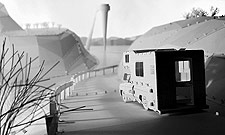 |
|
American
unreality: Ragsdales Wishram.
|
Everything
Is Illuminated
By
Meisha Rosenberg
The
Work of Ken Ragsdale
Photography
Center of the Capital District, Troy, through Dec. 28
Ken Ragsdale will tell you that he is an artist concerned
with the passage of time, and thats truehis photographs
convey the flat monumentality of childhood memories. But his
work is also invested with particularly American longings
and fears about life on the road. In this series, he remembers
childhood camping trips along the Lewis and Clark trail. Like
a memorable movie image by Antonioni or a photograph by Frank
Gohlke, each image uses lighting and careful staging to create
a palpable tension between objects in the landscape and the
viewers expectations. His work is complex, despite the repetition
of images, and worth getting to know.
Ragsdale, born in 1962, grew up moving frequently, from Walla
Walla, Wash., to northern Idaho, and he captures both the
era and the Pacific Northwest region. Especially his photographs
of campgroundsClarkston, Wallula, Arlington
(all works, 2008)reminded me of my childhood in the 1970s.
Perhaps its because of the precisely realized Ford Econoline
van circa 1961 that appears in several images. However, most
scenes generalize to a universally American atmosphere of
dislocation and unreality, that feeling that were all actors
on a cardboard stage. Wishram is a good example of this: in
it, a trailer drives away from the viewer down a winding highway
into a tired but cheerful yellow light. It could be anywhere
and any time in America where there are roads and inchoate
longings.
He places what he calls monsters in his photographs: a barn
on stilts and menacing, outsized objects suggestive of grain
silos or water towers that look like they mated with scalpels
and funnels. These surreal landmarks enhance the eeriness
that comes from blank paper props and colored gel-enhanced
lighting. The most astonishing thing is that, unlike Gregory
Crewdson and David Levinthal, who also photograph artificial
scenes, Ragsdale makes all his own detailed architectural
props from single pieces of white paper that he folds without
using glue or tape. He meticulously draws and cuts out shapes
with tabs, and in the final versions, the dotted lines from
his drawing phase are visible.
Because drawing is an important aspect of his work, some photos
are framed with images of drawings. Bushes shows the infinitesimally
small lines he drew for branches, and its not as compelling
as the finished photos, but its still interesting. He told
me, I wanted this process of thinking, sketching, making
drawings, cutting out, folding, setting up, taking photos,
as this idea that at each stage its just based on the last
stage and its constantly changing. At the Photography Center,
viewers are treated to the actual set he photographed for
this series, mounted on a table. Director Katherine Wright
delightedly pointed out that the paper barn has doors that
slide open, and the tractor wheels turn. Its a rare and generous
look at an artists methods.
Growing up he made shop drawings for his engineer father,
and he continued drafting at the Pacific Northwest College
of Art as a shop tech and as an assistant to sculptor William
Moore in Portland. His process didnt really come together
until when he was at grad school at SUNY. He was painting
when his teachers recommended he create scenes, which he then
photographed, and these images took on a life of their own.
Images such as The Campsite at Night, showing a Jeep
and van outside a barn lit brightly from above, would fit
in nicely at the current show Reality Check: Truth and
Illusion in Contemporary Photography at the Metropolitan
Museum of Art alongside works by Crewdson and Levinthal. His
work also has similarities with Gohlke and other practitioners
of New Topographicsphotographers who mined an uneasy relationship
to industrial scenery and who came together with a show at
the George Eastman House in 1975.
Its the America of lost dreams and sinister kidnappings lurking
just outside the frame of the picture, where a picnic table
has been overturned and a trash barrel rolls on the ground,
buffeted by an unseen wind. In Wallula, the Ford Econoline
and a barn radiate with alien light. One can see the outline
of every branch of tree and bushes, and we can see the emptiness
inside the van. Ragsdale explained, When you see the final
image youre never really confused as to what it is. Its
paper. Its folded paper. But when its constructed and photographed
you know immediately that its also something else. His unpopulated
scenes suggest ambiguous narratives: why did the barrels fall
over? Where are the cars going? His life-sized paper station
wagon hanging above an escalator in Concourse B at the Albany
airport, The Quest, is one of my favorite items there,
because it so perfectly suggests the anonymity and narrative
possibilities of travel.
A teacher at the College of Saint Rose and RPI, Ragsdale will
also have work as part of a group show at the Amrose Sable
Gallery this month. But if youve never been to the Photo
Center, make it a point to visit. Its a wonderful resource.
Ragsdales photos are an example of the kind of cutting-edge
work the center aims to inspire.
|

